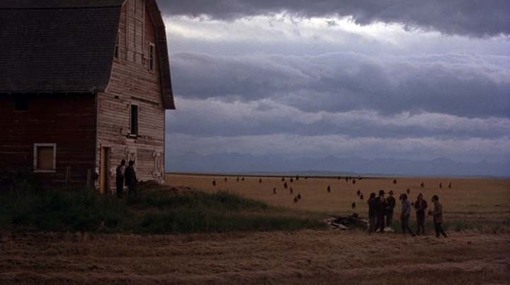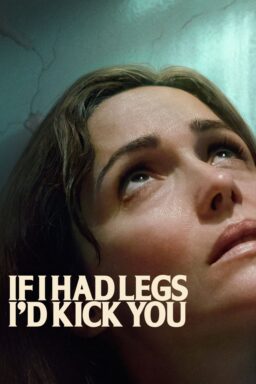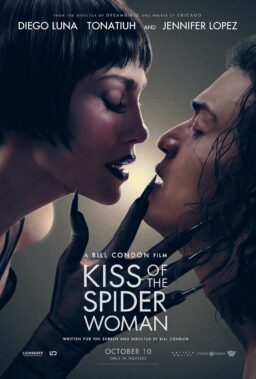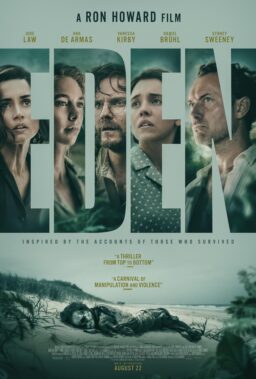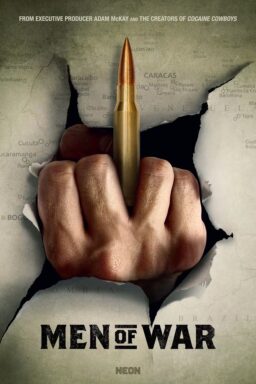“Troops of nomads swept over the country at harvest time like a visitation of locusts, reckless young fellows, handsome, profane, licentious, given to drink, powerful but inconstant workmen, quarrelsome and difficult to manage at all times. They came in the season when work was plenty and wages high. They dressed well, in their own peculiar fashion, and made much of their freedom to come and go.
“They told of the city, and sinister and poisonous jungles all cities seemed in their stories. They were scarred with battles. They came from the far-away and unknown, and passed on to the north, mysterious as the flight of locusts, leaving the people of Sun Prairie quite as ignorant of their real names and characters as upon the first day of their coming.”
— Hamlin Garland, “Boy Life on the Prairie” (1899), epigraph for Terrence Malick‘s screenplay for “Days of Heaven,” revised June 2, 1976

At some point in 1976, “Days of Heaven” was a screenplay that contained conventionally discrete scenes, developed exchanges of dialog and a fairly straightforward (melo-)dramatic narrative structure. Principal photography took place that year in the plains of Alberta, Canada (standing in for the Texas panhandle shortly before World War I), and the movie that emerged in 1978, after two years of editing, did away almost all of it. What the movie became — as everyone couldn’t help but notice at the time of its original release — is a film in which the “background” (nature, the landscape) moves into the foreground and the human characters recede into macrocosmic expanses of earth and sky, and microcosmic observations of flora and fauna. And bugs.

Terrence Malick’s vision is reflected in his process, whereby an enormous amount of material — scripted and unscripted, A-roll and B-roll — is pared down, peeled back, opened up.¹ Camera operator John Bailey, in an interview on the Criterion Blu-Ray edition of “Days of Heaven,” describes how the so-called “second unit” work. The close-ups of animals or plants, or the pastoral images of trees or streams are “very, very inserty-type shots, and yet they have the same kind of dramatic impact” as the spectacular wide shots — or, for that matter, the scenes involving the lead actors. Some complained about that at the time — that the film was gorgeous but insufficiently developed as human drama, that characters were cyphers, that the technique was “intolerably artsy” and “artificial.”²

Look at the movie and the first thing you notice is that, from the very beginning, speech is diminished, de-emphasized — drowned out in the opening scene by the roaring and pounding of the hellish factory. We don’t know exactly what caused the flare-up between Bill (Richard Gere) and the mill foreman (Stuart Margolin) because the words they’re saying have been all but eliminated. The next voice we hear, and the first we hear clearly, is narration — spoken, as it turns out, by the girl, Linda (Linda Manz), who we’ve seen in the last sepia photo of the opening titles montage, which includes many famous photographs from early 20th century America, with an emphasis on urban labor and poverty. (More about the narration later on.)

Throughout the film, dialog scenes, when they occur at all, are distilled to one or two lines — or one or two exchanges — between two people at a time. There may be three or four longer scenes that feature more extensive conversation, but that’s about it. There’s the furtive, halting proposal the terminally diagnosed farmer (Sam Shepard) makes to Abby (Brooke Adams), the discussion between Bill and Abby about whether she should accept… But the earliest one is right after Bill, Abby and Linda have arrived in Texas, between Linda and her nameless new acquaintance (Jackie Shultis). It’s my favorite dialog scene in the movie — and probably the longest — just two girls walking through a field of wheat, getting to know each other. Linda says she has a brother — Bill: “He’s somewhere…” she motions off-screen, into the distance, “I don’t know, over there, I don’t know.”


That, for me, slyly sums up the visual strategy of the film: The lead characters are often somewhere, I don’t know, over there. Malick is equally (perhaps more) interested in the plants and the critters that inhabit the earth alongside them, and sees humans on that scale. Out here in the fields, mankind is just another critter — no matter that he has gigantic, roaring, infernal machines to help turn land into property and property into money; no matter that a Victorian mansion can bring the comforts of the indoor civilization to the vast plains, even though it looks like an incongruous matchstick miniature when seen against the horizon.
So, if you take the drama out of the dialog and the performances, where does it go? Into the world at large. After all, humans have no more control over their unpredictable, unmanageable emotions (or, ultimately, their destinies) than they do over wild creatures, the land, the tides, the weather, or the seasons.

Malick’s drama is elemental in every sense of the word. (Earth, air, water, fire.) The story of “Days of Heaven,” like the title,³ has biblical resonances that suggest the Fall (not that migrant labor on a wheat farm is itself Edenic) and the serpent, Cain and Abel (though Bill and the farmer are not literally brothers, what happens between them is a form of fratricide), apocalyptic accounts of the Last Judgment (from a guy named Ding Dong, according to Linda’s voiceover) and, of course, a plague of locusts, among other biblical images and motifs. Even the fact that lovers Bill and Abby are masquerading as brother and sister (when Linda is Bill’s real sister) seems somehow like a violation of the natural order. Other workers sense there’s something not right (“Your sister keep you warm at night, does she?”) — whether it’s deceit or incest.
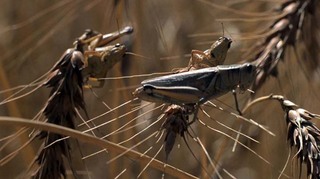
Does nature become a manifestation of God’s Judgment, or of the characters’ emotions? You could look at it that way, but it seems to me that the movie is up to something less direct or definitive. The people, the animals, the vegetation, the land, the sky, the water, the weather… they flow in and out of one another not just because they are fundamentally inseparable in nature, but because they are the dream, the poem, the movie we’re witnessing.⁴

Philosopher Simon Critchley put it nicely in a 2002 piece about “The Thin Red Line” and what he calls “Three Hermeneutic Banana Skins” that can slip one up when describing or interpreting Malick’s films. The first two involve the temptation to speculate about Malick’s “reclusive,” “enigmatic” personal life outside the film industry — and particularly his academic background in philosophy. And then:
To read from cinematic language to some philosophical metalanguage is both to miss what is specific to the medium of film and usually to engage in some sort of cod-philosophy deliberately designed to intimidate the uninitiated. I think this move has to be avoided on philosophical grounds, indeed the very best Heideggerian grounds. Any philosophical reading of film has to be a reading *of* film, of what Heidegger would call *der Sache selbst*, the thing itself. A philosophical reading of film should not be concerned with ideas about the thing, but with the thing itself, the cinematic *Sache*. It seems to me that a consideration of Malick’s art demands that we take seriously the idea that film is less an illustration of philosophical ideas and theories — let’s call that a *philoso-fugal* reading — and more a form of philosophising, of reflection, reasoning, and argument.

This goes for film theory as well as philosophy — movies shouldn’t be shoehorned into some theoretical template, just because it happens to be fashionable at the time.⁵ The process of watching the movie is essential experience; the movie is not merely a substitute for something else. Yes, movies are metaphors in light and shadow — representational (even if impressionistic) because cinema is (or was, at least as recently as 1978) a photographic medium. But metaphors are both the object and the subject at the same time, not just one thing standing in for the other, and they have multiple properties. That’s also one of the things I think Dwight Macdonald is getting at in the quotation in the right-hand column above: “An idea does not exist apart from the words that express it. Style is not an envelope enclosing a message; the envelope is the message.” (You can substitute “images” for “words,” and don’t take the “message” part too literally; I think Macdonald means something closer to “idea” or “concept.”) And this is partly what I mean when I say that Malick’s filmmaking methods are the expression of his vision.⁶

Wim Wenders once told me in an interview something that many other filmmakers have expressed in various ways — that he is always making two films: the one he thought he was going to make when he set out, and the one he discovers along the way. Each is a reflection of the other, though they are not precisely reverse images. That’s the way I see Malick’s approach to filmmaking reflected in the films themselves, the humans reflected in nature (and vice-versa). I envision these things the way Adrian Martin describes the film’s music in his splendid essay that accompanies the Criterion edition of “Days of Heaven”:
Malick’s underlying aesthetic aim–one he shares with several great directors, and which was already evident in “Badlands“–is to encourage the proliferation of a wide range of moods, sights, sounds, and surface textures, while simultaneously arriving at an overall, unifying form. Nothing expresses this better than one of the most beloved elements of “Days of Heaven,” its play of different musical “inputs,” those Malick appropriated alongside those he commissioned: the music veers from classical to folk, but what holds the ensemble together is that Ennio Morricone’s grave score literally inverts the melody of Saint-Saëns’s Carnival of the Animals. One reflects the other, just as land and sky reflect each other in those characteristic Malick panoramas bisected by the horizon line.
Which leads us back to that narration (for lack of a better word). The first fully intelligible language spoken in “Days of Heaven” is from the narrator, Linda, who is both within the world of the film (she’s an onscreen character) and floats outside it from a perspective that is part memory (related in the past tense) and is embellished imagination: “Me and my brother. It just used to be me and my brother,” says Linda, the girl from the photograph, her first words establishing her relationship to the man we’ve just seen, and setting the events of the film in the past as she recalls them. Only… not quite.
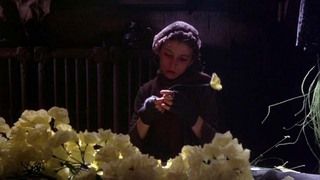
Matt Zoller Seitz has aptly described her voiceover as “contrapuntal narration,” in that it is a parallel element (to the film’s diegetic and non-diegetic sounds and images, including music and sound effects) that establishes a harmonic relationship with them while remaining distinct. The Linda we hear (Critchley describes Malick’s use of narration as being “like watching a movie with someone whispering into your ear”) seems to be the girl we see on screen and an older observer, looking back on (and simultaneously [re-]creating) the film we’re watching from some theoretical viewpoint in the future. Her narration does little to move the story along. Instead, she muses about her own thoughts and feelings, tries to explain the world as she experiences it, and speculates about the feelings and motivations of others.

“Me and my brother. It just used to be me and my brother,” We hear those initial words as the as-yet-unnamed Bill runs off after having decked the mill foreman. How do we know that guy is her brother? Well, we don’t… for a while. “We used to do things together,” she continues. “We used to have fun. We used to roam the streets. There was people sufferin’ of pain and hunger, some people their tongues were hangin’ outta their mouth.” Next we see her (we should recognize her as the narrator by now) at work, making pale yellow paper flowers. Cut to Bill and Abby (we’ve first seen her sorting through scrap metal in the movie’s second post-titles shot).


When Linda says in voiceover, “In fact, all three of us been going places, lookin’ for things, searchin’ for things, goin’ on adventures.” it doesn’t make strict grammatical sense (if feels like a fragment slipped into this context), but her rising tone indicates the start of a journey, in harmony with the Leo Kottke guitar music that rises on the soundtrack and the image of Bill, Abby and Linda, bags in hand, running across a train yard, followed by the first of the film’s breathtakingly spectacular images: the silhouette of a train crossing a bridge against the sky. (I remember 1978 audiences gasping at the 70 mm imagery.)
It’s really not until we see the three among the crowd atop the train cars that we put the pieces together: “They told everybody they were brother and sister. My brother didn’t want nobody to know. You know how people are. You tell ’em somethin’, they start talkin’.” This manner of slowly revealing information is typical of Malick, as Ignatiy Vishnevetsky writes in “‘The Tree of Life’: A Malickiad.” I’m sorry to quote a piece when I’ve only read its first two paragraphs (I haven’t seen “The Tree of Life” yet, so I’m trying to avoid reading anything about it), but this is just terrific:
In “The Tree of Life,” we know that Brad Pitt‘s unnamed, self-styled paterfamilias is a light smoker not because it’s ever said or observed, but because he is specifically never shown smoking— yet at one point asks for his lighter, which his son sullenly sets down on a coffee table next to a pack of cigarettes. It’s a half-full soft paper pack, the kind that would quickly become crinkled if kept in a coat pocket, but is perfectly intact, as if kept in a drawer.
There are two key ingredients at work here. The first is Terrence Malick’s peculiar way with minor objects and details. The second is the absence of major details, and the subconscious detective-work that occurs on the part of the viewer. In order to just keep up with the flow of action, with the pace of a scene, the audience has to piece together characters and events based on stray clues. “The Tree of Life” appears to be staging a family chamber drama (the most insular of genres, where even the characters form a self-contained unit) on a cosmic scale…

I would say much of this applies to “Days of Heaven,” as well — especially in the first half hour or so, when so very few words are spoken. Then there are larger mysteries: Is the farmer really sick? We have only Linda’s speculations about a conversation her brother says he overheard. Critchley writes that “Malick’s male protagonists seem to foresee their appointment with death and endeavour to make sure they arrive on time,” and suggests that the farmers rendezvous with destiny in the blackened wheat field is just what he had desired. Is this triangle an attempted suicide by proxy? Or a murder? Why does the image of the serpent in Linda’s picture book dissolve into a shot of the farmer writhing in pain on his bed? Is he ill, or is he in pain because of what he suspects?

Back again to the narrator. Linda’s tone is simultaneously wistful and matter-of-fact, naive and worldly, delivered in a raspy, ruminative tough-girl dialect. “Unreliable” would be overstating the case, but she’s not omniscient, either. She’s still a character (or “karactuh,” as she might say) in the story — but she seems to have access to scenes she couldn’t know about first-hand. Maybe she heard about ’em from somebody later, I don’t know. There are times (as in her account of the Last Judgment, relayed to her by Ding Dong) when she seems to want to shock the listener, or to impress us with her street-sophistication, her humor or her grown-up-sounding depth of feeling. Even then, she speaks in the language of a youngster trying to sound adult: “In one way I felt sorry for him, ’cause he had nobody to stand out for him, be by his side, hold his hand when he needed some attention or somethin’. That’s touchin’.”
One explanation for that language, that tone, is that, as Manz recalls (in a recent interview in the Village Voice), she improvised most of it: “This was later on: They took me into a voice recording studio. No script, nothing, I just watched the movie and rambled on… I dunno, they took whatever dialogue they liked.” (As for Ding Dong, Manz says, “I just made that up.”)

You can hear the edits, changes in tone of voice and even in audio quality in the narration (right there in the Ding Dong apocalypse, in fact), indicating how it was assembled over time, pieced together into a collage. This is consistent with the accounts from the actors and editors on “The Thin Red Line” two decades later, including Billy Weber, who also edited “Days of Heaven”) — that Malick would strip away the dialog in the footage he’d shot and replace it with a few lines of narration, whether written for the purpose or improvised, which they’d record and then lay over sections of the picture. During production, Malick would shoot the same scene throughout the course of a day, in different lighting and weather, so that he could use it “anywhere” — and would often insist on at least one take in which the actors performed the scene without dialog altogether.

Watching “Days of Heaven” the other night for the first time in at least 20 years, I didn’t know any of the things I’ve mentioned above about its making (or the making of other Malick pictures), but in retrospect it all seems to make perfect sense. That’s the way the movie feels — like Linda is both in the movie and standing outside of it, commenting on the thoughts and feelings she has while watching it pass by (though the observations don’t necessarily, precisely match up with what is on screen at any given moment).
Again, Adrian Martin writes:
Above all, the radical strangeness and newness of “Days of Heaven” was signaled to its first viewers by its most fragmented, inconclusive, “decentered” feature: the voice-over narration of young Linda Manz as Linda, Bill’s actual sister, who is along for the ride, often disengaged from the main action but always hovering somewhere near. It might have seemed, at first twang, like a reprise of Spacek’s “naive” viewpoint from “Badlands,” but Manz’s thought-track goes far beyond a literary conceit. It flits in and out of the tale unpredictably, sometimes knowing nothing and at other times everything, veering from banalities about the weather to profundities about human existence. Sometimes even her sentences go unfinished, hang in midair. In this voice we hear language itself in the process of struggling toward sense, meaning, insight–just as, elsewhere, we see the diverse elements of nature swirling together to perpetually make and unmake what we think of as a landscape, and human figures finding and losing themselves, over and over, as they desperately try to cement their individual identities or “characters.”

Bilge Ebiri, Matt Zoller Seitz and others have written about how the multiple narrations of “The Thin Red Line” (1998) and “The New World” (2006) seems to strain against the limitation of language, and you can sense this even in the narration, both banal and poetic, of Holly (Sissy Spacek) in “Badlands” and Linda in “Days of Heaven.” (And I would argue that the banalities and the profundities are inseparable — that the comments about the weather may be more profound than the attempts at profundity about the human condition — and that’s what makes these voiceovers so moving and musical.)
The images strain against similar limitations. For example, there’s no way to quite capture what is expressed in the shot in which witnesses to a killing stand on the far side of a river flowing so fast and so smoothly that it’s almost dizzying. There is only the image, and how it feels, as if time and life itself are visibly streaming past them, and there is no possibility of crossing. That’s the movie.
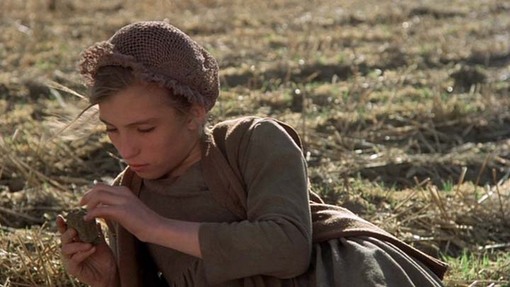

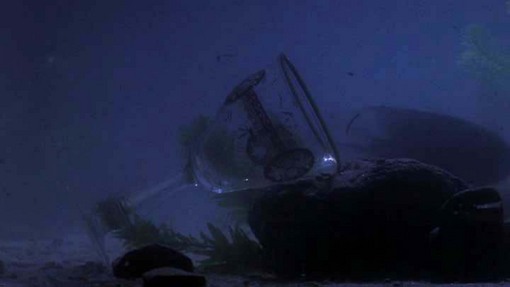

– – – – –
¹ “The Thin Red Line,” Malick’s next film after “Days of Heaven” 20 years later, was estimated to have been sculpted into a 170-minute film from approximately 170 hours of footage.
² Review of “Days of Heaven” by Harold C. Schonberg (New York Times, September 14, 1978).
³ The title, from Deuteronomy 11:21, was spoken by a preacher as a prayer at the start of the harvest. Though you can’t hear it in the movie, it appears in the script: “… that your days may be multiplied, and the days of your children, in the land which the Lord swore unto your fathers to give them, as the days of’ heaven upon the earth.”
⁴ And a cigar may sometimes be a cigar, but if it’s in a movie it’s never just a cigar. It can’t avoid being a metaphor, a representation. I’ve tried to avoid the language of semiotics — “signs” and “signifiers” — because that’s not my bag. It was not part of our cinema studies curriculum at the University of Washington in the 1970s. I never got beyond Peter Wollen’s Signs and Meaning in the Cinema (1969).
⁵ See Post-Theory: Reconstructing Film Studies (1996), edited by David Bordwell and Noël Carroll.
⁶ Adrian Martin also bemoans simplistic/reductive approaches to Malick, whom he calls “a poet of the ephemeral”:
Malick’s films have sometimes been frozen, by those unsympathetic to them, into pious homilies or grand statements: Man versus Nature, the redemptive path to God via love and sacrifice, the corrupting effects of Civilization encroaching upon an idyllic Wilderness… Yet nothing is so certain or schematic in his work. As always, everything is in motion, seeming opposites ceaselessly transforming each other….


